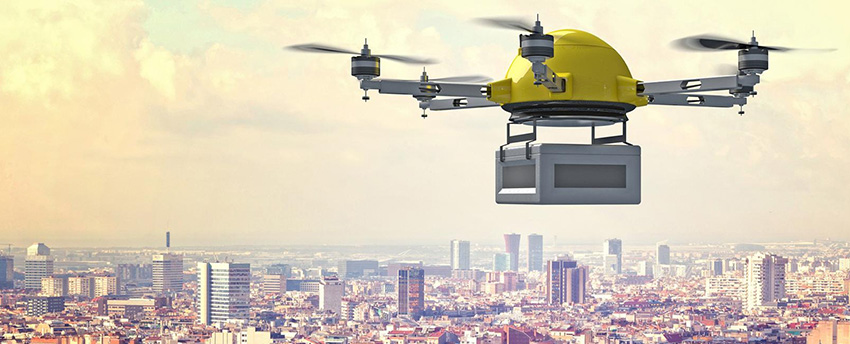E-commerce and last mile delivery: what’s in store for us?
E-commerce and last mile delivery: what’s in store for us?
Online commerce is becoming more and more widespread. A crucial part of e-commerce is the delivery of the goods. How does digitalisation change the challenges and possibilities of delivery?
The last mile
Instead of shopping in a store, more and more people are choosing ordering online in both the business and the retail sectors. Also, with the spread of big online warehouses (such as Amazon, eBay or AliExpress) it is becoming more common to order goods from abroad. The first section of delivery happens through ships or railways, until the goods arrive at a transportation hub, from where they are shipped off to finally get to the addressee.
The term “last mile delivery” marks the process when the goods get from the transportation hub to its final destination. E-commerce has a great impact on this phase of delivery as well. Let’s see what are the most important challenges and solutions in this area.

Autonomous vehicles and drones
Of course, one of the most important novelty in the area is the mode of transportation. In a previous article where we summarised the trends of logistics in 2018, we have already written about autonomous vehicles, which are still being tested, but which can also become the future of delivery in a few years.
If robots and self-driving cars were to be used in last mile delivery, a significant amount of costs could be saved. Human resources and employees mean the biggest cost in last mile delivery (about 60% of costs according to the data of Supply Chain Dive). If robots could do deliveries, you could not only save a significant amount of money, but you could provide delivery services at any time of day – which is one of the biggest challenges of the industry today. Drones are a similar story. They are already being tested in a few American cities. If you want to apply drones in last mile delivery, you will need strict regulations, because it is quite easy to abuse the technology, and there will probably be a limit on their use in more urbanised areas.
One of the shortcomings of the system is that there might be a system error during the delivery process – which means that it is necessary to use human power in order to provide the smooth and error-free operation of the system.
Faster delivery
One of the most important factors of last mile delivery is speed: it is crucial that the ordered goods get to the addressee in the fastest way possible – for the satisfaction of the customer is one of the most important aspects that make the customer choose your service the next time as well.
It is becoming more and more widespread in the USA and Western countries to do grocery shopping and ordering pharmaceuticals online as well. This habit has started circling into Hungary, too. And the customer wants to know exactly when the goods are arriving. In order to provide such a service, you need faster information processing and careful planning. According to the CEO of an online delivery company, as soon as an order comes in, it needs to be processed and (in case of same-day delivery) shipped.
The tracking of goods is one of the most important factors for the 21th century customer
Bigger delivery companies already have set up a tracking service. However, smaller or local delivery companies still do not have this function. But it is actually very important to today’s customers to always be aware of where the goods are at a given moment or when they can expect them to arrive at their place. This service also proves to be important if the parcel gets lost or is not delivered on time, because that way you can track where it got lost or when it was last seen in the system.
Bike delivery instead of drones
Until drones and robots are capable of delivering parcels with 100% reliability, the best solution in the industry seems to be bicycle couriers.
The main reason for that is cost-effectivity. Because of different regulations, drones and autonomous vehicles will probably not be available in urbanised areas. For this reason, the cheapest solution is bike couriers. Compared to cars, bicycle couriers do not have a disadvantage when it comes to speed; however, it costs reasonably less to maintain them than other types of vehicles.
Bike couriers are very common in the United States; what’s more, it is not only delivery companies who do last mile delivery, but startups have started to introduce a solution that is similar to Uber. The company sends out a notification to potential deliverers, who can decide whether they want to do the delivery for a given amount of money. This way, similarly to Uber, you don’t have to employ an actual delivery company, but people who have a bicycle or a car can deliver the parcels. This is also an excellent solution to lower costs and the use of human resources on the last mile.
From plan to reality in the next 10 years
Some of the ideas listed above may seem futuristic – it is quite hard to imagine to order something from the Internet, pay for it online, and get it the next day via drone delivery. However, these ideas are already being tested in the United States; and logistics and supply chain management companies must watch out in order to keep up with the changing trends of the era. The first step of this is automatisation and digitalisation.
It is also worth it to keep an eye on customer needs and how they have an effect on the trends and challenges of last mile delivery. Since the members of Generation Z have grown up in a world of smartphones and online shopping, the acceptance of technology is becoming more and more widespread in every aspect of life.
Sources: McKinsey, SupplyChainDIVE
Don't be left behind!


